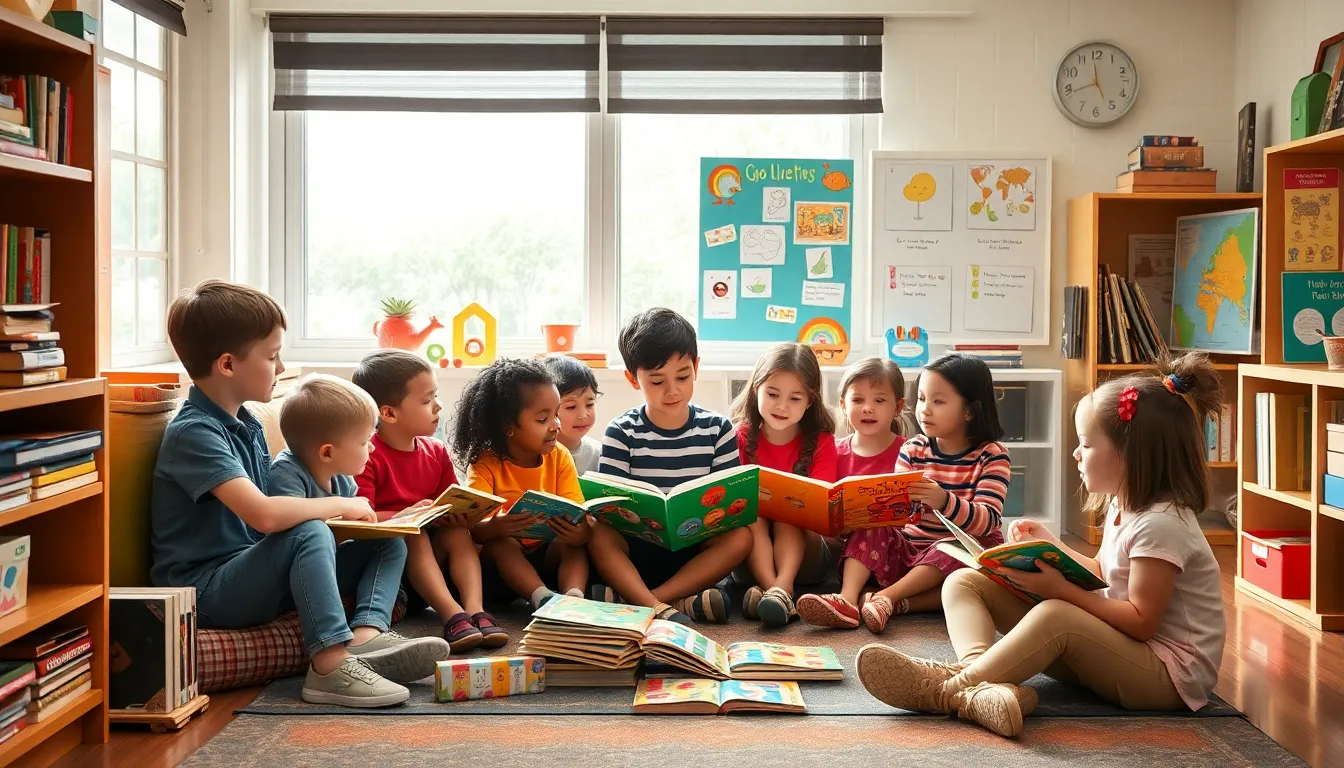Table of Contents
ToggleLanguage is a powerful tool that shapes how individuals connect with the world. Supporting language growth is crucial, especially during early childhood, as it lays the foundation for effective communication and cognitive development. Parents, caregivers, and educators play a vital role in nurturing this growth through engaging interactions and stimulating environments.
By fostering a rich linguistic environment, they can help children expand their vocabulary, enhance their understanding of grammar, and develop critical thinking skills. Simple activities like reading aloud, singing, and engaging in conversations can make a significant impact. As children explore language, they build confidence and creativity, setting the stage for lifelong learning and success.
Understanding Language Growth
Language growth involves the natural progression of acquiring language skills from infancy through childhood. This development is crucial for effective communication and cognitive skills.
The Stages of Language Development
Language growth occurs in several distinct stages:
- Cooing (0-6 months): Infants produce cooing sounds. This stage builds vocal cords and explores pitch.
- Babbling (6-12 months): Repetitive consonant-vowel combinations emerge, aiding in sound recognition and experimentation.
- Single Words (12-18 months): Children begin using single words to convey meaning. Vocabulary expands to include nouns and simple verbs.
- Two-Word Phrases (18-24 months): Children combine two words, demonstrating an understanding of basic sentence structure and relationships.
- Multi-word Sentences (24+ months): Language becomes more complex, with children forming complete sentences and asking questions. Vocabulary rapidly grows.
Key Factors Influencing Language Growth
Several key factors impact language growth:
- Exposure: Frequent interactions with adults and peers enhance vocabulary and comprehension.
- Quality of Interaction: Engaging dialogues, storytelling, and rich language experiences foster deeper understanding.
- Socioeconomic Status: Access to resources and educational opportunities can affect language acquisition.
- Cultural Context: Cultural practices and values shape language use and development.
- Individual Differences: Each child’s personality, temperament, and developmental pace play roles in their language growth trajectory.
These factors collectively contribute to the effectiveness of language development strategies and the overall linguistic environment for children.
Strategies for Supporting Language Growth

Supporting language growth involves implementing effective techniques to enhance children’s communication skills. These strategies create engaging experiences that foster vocabulary expansion and promote deeper understanding.
Interactive Reading Techniques
Interactive reading methods enhance children’s engagement and comprehension. Techniques include:
- Asking open-ended questions during reading sessions. Questions like, “What do you think will happen next?” stimulate critical thinking.
- Using expressive voices and gestures to maintain interest. This brings stories to life and encourages emotional connections.
- Encouraging children to predict outcomes or retell stories. This promotes narrative skills and reinforces memory.
- Incorporating visual aids, such as pictures or props. Visual elements provide context and aid understanding.
Encouraging Conversation and Vocabulary Building
Engaging children in conversation is vital for language development. Effective practices include:
- Initiating daily conversations, even during routine tasks. Asking, “What do you want for lunch?” encourages choice and vocabulary use.
- Expanding on children’s responses. If a child says, “I saw a dog,” responding with, “What color was the dog?” reinforces descriptive language.
- Introducing new words in context and explaining meanings. If the word “adventure” arises, defining it in a relatable scenario enhances understanding.
- Providing opportunities for social interaction. Playdates and group activities enhance conversational skills among peers.
These strategies create an enriching environment that supports language growth while building children’s confidence and communication abilities.
The Role of Technology in Language Growth
Technology plays a significant role in supporting language growth by providing diverse tools and resources for children. With the right applications and learning platforms, children can engage with language in interactive and meaningful ways.
Educational Apps and Resources
Educational apps serve as valuable resources for language development. Programs like Endless Alphabet and Duolingo ABC enhance vocabulary and phonics skills through interactive games. These apps create opportunities for personalized learning experiences that adapt to each child’s pace. Online platforms also offer videos, stories, and songs that introduce new concepts and vocabulary in captivating formats. Research indicates that children exposed to high-quality educational technology demonstrate improved language skills, increased engagement, and enhanced retention of new information.
Balancing Screen Time with Interactive Learning
Balancing screen time with interactive learning is essential for optimal language growth. Establishing guidelines for technology usage ensures children benefit without relying solely on screens. Engaging in face-to-face interactions while incorporating technology strengthens language skills. For instance, parents can use apps for learning activities together, promoting shared experiences and conversations. Limiting screen time to specific durations while prioritizing direct engagement helps reinforce language acquisition. This balance supports a holistic approach to learning, blending the benefits of technology with the necessity of personal interactions for comprehensive language development.
Supporting Language Growth in Diverse Learners
Supporting language growth in diverse learners involves tailored strategies that acknowledge individual backgrounds and language experiences. Emphasizing inclusivity and responsiveness to each child’s needs fosters a nurturing linguistic environment.
Strategies for Bilingual and Multilingual Children
- Encourage both languages: Provide opportunities for children to engage with their home language and the language of instruction. This reinforces fluency in both.
- Integrate cultural resources: Utilize books, songs, and stories from various cultures. Exposing children to diverse narratives enhances cultural understanding and language skills.
- Facilitate language play: Use games and playful activities that incorporate elements from both languages. Playful interactions encourage natural language use and reinforce vocabulary.
- Promote peer interactions: Encourage children to interact with peers who speak different languages. These interactions enhance social connections while supporting language growth.
- Support family involvement: Engage families by offering resources in multiple languages. Family participation strengthens the linguistic bridge between home and educational settings.
Cultural Considerations in Language Support
- Acknowledge diverse experiences: Recognize that each child comes with unique cultural backgrounds that shape their language learning. Understanding these backgrounds informs effective teaching practices.
- Respect language dynamics: Value the home language and its role in identity. Promoting appreciation for a child’s linguistic heritage fosters confidence and engagement.
- Adapt communication styles: Different cultures may have varying communication norms. Adapting instructional strategies to reflect these backgrounds improves understanding and connection.
- Implement culturally relevant materials: Use teaching materials that reflect the diverse cultures present in the classroom. Culturally relevant content boosts motivation and supports meaningful learning.
- Create an inclusive environment: Foster a classroom atmosphere where all languages and cultures are celebrated. An inclusive environment encourages children to express themselves and engage fully.
Supporting language growth is a vital investment in a child’s future. By fostering a rich linguistic environment filled with engaging interactions and diverse resources, adults can significantly enhance children’s communication skills. Simple yet effective strategies like reading aloud and encouraging conversation play a crucial role in this process.
Embracing individual differences and cultural backgrounds ensures that every child receives the support they need. Balancing technology with personal interaction creates a holistic approach to language development. Ultimately, nurturing language skills not only builds confidence but also lays the foundation for lifelong learning and success.







